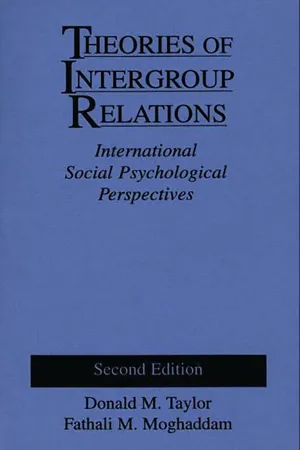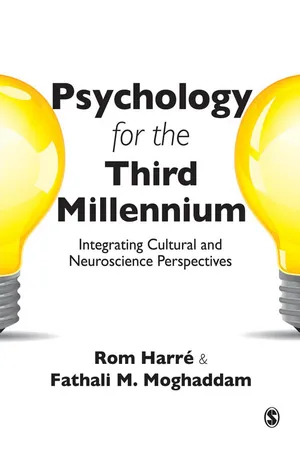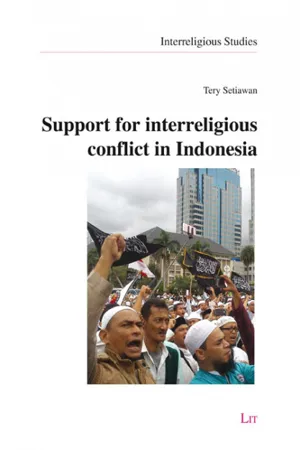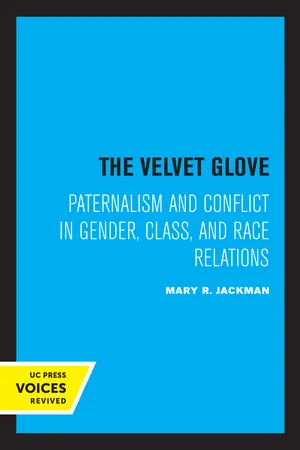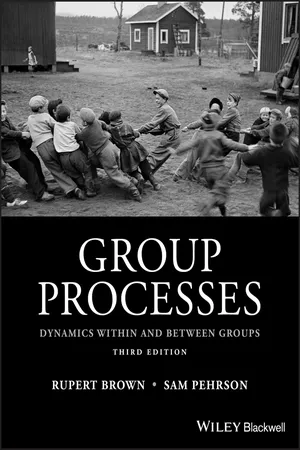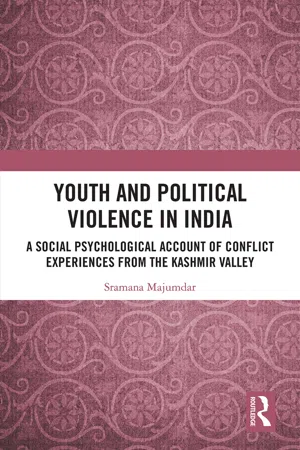Psychology
Realistic Conflict Theory
Realistic Conflict Theory suggests that intergroup conflicts arise from competition over limited resources, leading to negative attitudes and behaviors between groups. This theory emphasizes the role of economic and political factors in fueling intergroup hostility and discrimination. It highlights how perceived competition can exacerbate tensions and contribute to prejudice and discrimination between different groups.
Written by Perlego with AI-assistance
Related key terms
1 of 5
8 Key excerpts on "Realistic Conflict Theory"
- eBook - PDF
Theories of Intergroup Relations
International Social Psychological Perspectives
- Fathali M. Moghaddam, Donald M. Taylor(Authors)
- 1994(Publication Date)
- Praeger(Publisher)
3 Realistic Conflict Theory (RCT) is essentially an economic theory of intergroup behavior that is based upon three central assumptions about human behavior. First, it is assumed that people are selfish and will try to maximize their own rewards. Second, conflict is assumed to be the outcome of incompatible group interests. Third, it is assumed, sometimes explicitly, that the social psychological aspects of intergroup behavior are not determinants of—-but, rather, are mainly determined by—the com- patibility or incompatibility of group interests. For example, the negative attitudes, stereotypes, and attributions that members of one group have regarding members of an out-group are assumed to stem from the incom- patible interests of the two groups involved. The work of social psychologists guided by RCT is in an important sense devoid of social psychology. Once it is assumed that real conflicts of interests are the cause of intergroup hostility, and intergroup behavior is mainly determined by the compatibility or incompatibility of group goals, then social psychological phenomena assume the role of dependent vari- ables in the intergroup setting. For example, Sherif states that "the bounds for the attitudes of members in different groups towards one another are set by the nature of the functional relations between groups" (1966, p. 63). He proceeds to describe in more detail what these functional relations are: Groups may be competing to attain some goal or vital prize, in which the success of one group necessarily means the failure of the other. One group may have claims on another group to manage, control, or exploit them, to take over their Realistic Conflict Theory 36 Theories ofIntergroup Relations actual or assumed rights and possessions. On the other hand, groups may have complementary goals, so that each may attain its goal without hindrance from the others or even with their helping hand. - eBook - PDF
International Political Psychology
Explorations into a New Discipline
- Anna Cornelia Beyer(Author)
- 2016(Publication Date)
- Palgrave Macmillan(Publisher)
30 A.C. BEYER that this model can be applied to IR, as most of the identified factors have been mentioned in International Relations literature (see below) but so far have not yet been connected in the way that I propose here. SOCIAL PSYCHOLOGY AND CONFLICT The first attempts to understand conflict through a Social Psychology per- spective led to the emergence of Realistic Group Conflict Theory. 20 It states that conflicts of interest, found in competition over scarce resources, for example, bring forth conflicts. Cross-cultural evidence supports this claim. 21 However, it was later argued that conflict of interest presented only a sufficient but not a necessary condition for conflict. Discrimination can occur already as a result of the simple knowledge of the existence of another group. 22 Social Identity Theory (SIT) 23 developed out of the latter findings and a general dissatisfaction with Realistic Group Conflict Theory. In opposi- tion to Muzafer Sherif’s claim that competitive goals cause conflict, it argues that social categorisation per se can cause intergroup discrimina- tion. Social Identity Theory focuses on identities, which are the basis of group formation. It maintains that group formation and accordingly self-categorisation form the basis for conflict. Humans easily form ‘in’- groups and ‘out’-groups; and as soon as we form groups, we start to dis- criminate against the other groups. We start to favour the in-group, our group, the ‘we’-group; and we start to compete with and try to exploit the out-group, the others. This argument is based on some simple experi- ments. 24 Researchers presented individuals with cues, such as dots on a slide or painted pictures, and divided them into groups according to their responses to these cues. For example, whether the individuals had overestimated or underestimated the number of dots on the slides deter- mined the group they would belong to. - eBook - ePub
Psychology for the Third Millennium
Integrating Cultural and Neuroscience Perspectives
- Rom Harre, Fathali M Moghaddam, Rom Harre, Fathali M Moghaddam(Authors)
- 2012(Publication Date)
- SAGE Publications Ltd(Publisher)
Muzafer Sherif (1906–1988) was a Turkish-American psychologist who conducted brilliant research on norm-formation and conformity to group-established norms, but also made seminal contributions in the area of intergroup relations. Sherif’s approach is given the title of ‘Realistic Conflict Theory’ because he adopts a ‘realist’ approach in viewing psychological experiences, such as intergroup attitudes, as being shaped by material conditions. For Sherif, how people feel and act toward outgroup members is determined by whether their group is in competition with the outgroup for material resources: If Group A and Group B are in competition for land and water, then they will have negative attitudes toward one another and violent conflict might arise; if Group A and Group B have common material interests, then they will be positively disposed toward one another.Sherif provided a compelling set of demonstrations of his theory in the context of boys summer camps. The basic design of the study was simple. The researchers acted as camp counselors and welcomed boys to summer camp. The boys were selected to be similar in terms of key demographic characteristics, so that ‘natural groupings’ (e.g. ethnicity) would interfere as little as possible (all the boys were 11–12-year-old White Christian Americans). During stage one, the boys became acquainted with one another, and some became friends. During stage two, the boys were divided into two groups, making sure that all those who had been identified as forming friendships were assigned to different groups. This was done so that ‘friendship patterns’ could not account for subsequent findings. During stage three, the two groups engaged in various types of intergroup competition, over both material prizes and prestige. Attitudes against the outgroup became more biased. Negative intergroup feelings intensified and more aggressive leadership emerged in each group. The groups engaged in acts of destruction and violence against each other. Having managed to get the two groups to hate one another, the challenge was now for Sherif to move them back to peaceful relationships again. During stage four, Sherif introduced superordinate goals, goals that both groups wanted to achieve but neither could achieve without the cooperation of the other. For example, a food truck ‘broke down’ and in order to pull the truck into the camp, the two groups had to cooperate. Through superordinate goals, relationships between the two groups became cooperative again. In a sense, the boys went back to being one group again. - Tery Setiawan(Author)
- 2020(Publication Date)
- LIT Verlag(Publisher)
This model is important to explain the psychological mechanism of collective action via perceived injustice and collective efficacy. Finally, we complement social identity theory using intergroup contact theory (section 2.4). By employing this theory, we take into account relevant factors that help to lessen outgroup derogation in times of intergroup competition. The present study aims to use the two different approaches and synthesize them in a more comprehensive outlook. This synthesis is encapsulated in a research model (Figure 2.6) that links the macro-sociological and micro-psychological explanations of support for interreligious conflict. We end this chapter by providing the overall macro-micro level perspective and the research model (section 2.7). 2.1 Realistic Conflict Theory Coser’s (1956) conflict theory is aligned with Sherif’s (1967) and Levine and Campbell’s (1972) conflict theories. While Coser rose his theory from the sociological world and Sherif proposed his from the socio-psychological world, 36 CHAPTER 2 Levine and Campbell drew their theory, focused on ethnocentrism, from the combination of anthropology, sociology, psychology, political science and economics. Separated by their paradigms, these authors interestingly agreed that competing for access to limited resources leads to conflict between groups. Many theorists label these theories as realistic group conflict theory (e.g., Scheepers, Gijsberts, & Coenders, 2002; Schneider, 2008; Tajfel & Turner, 1979). In order to avoid confusion, we only use Coser’s label ‘Realistic Conflict Theory’ for the purpose of this study. It is important to start off by explaining the central notion of Coser’s theory and the extension to it. Next, we will explain the link between Coser’s theory, Blalock’s (1967) competition theory, and Blumer’s (1958) group position theory in looking at support for interreligious conflict.- eBook - PDF
The Velvet Glove
Paternalism and Conflict in Gender, Class, and Race Relations
- Mary R. Jackman(Author)
- 2023(Publication Date)
- University of California Press(Publisher)
This loose school of thought warrants separate discussion because it represents a different attack on the problem of racial attitudes which abandons many of the central tenets of the prejudice literature; at the same time, it does not abandon the primary concern with conflict as the core factor in intergroup attitudes. The exact arguments made by schol- ars using the realistic group conflict perspective vary somewhat, but the perspective may be described as roughly analogous to the interest-group approach in the class literature: racial groups are seen at least in part as having distinctive interests that engender conflict. LeVine and Campbell (1972, 29) provide a clear summary of this approach: This theory assumes that group conflicts are rational in the sense that groups do have incompatible goals and are in competition for scarce re- THE SEARCH FOR CONFLICT 39 sources. Such "realistic" sources of group conflict are contrasted with the psychological theories that consider intergroup conflicts as displacements or projective expressions of problems that are essentially intragroup or intraindividual in origin. . .. Not all of them eschew psychological explana- tions. .. . But for all, realistic sources of group conflict are a primary em- phasis. Blumer's essay on "Race Prejudice as a Sense of Group Position" (1958) provides the roots (albeit rather tenuously) for this school of thought. Blumer made the case that prejudice should not be seen as a property of individuals, but of groups seeking to protect their position against possible incursions by subordinates. He introduced the idea of prejudice as motivated by feelings of threat, but he held back from locat- ing those feelings in tangible advantages enjoyed by the dominant group. Blumer's "sense of group position" was a subjectively shared, group-level "sense" rather than a response to tangible, group-level interests (see also his discussion of the impact of industrialization on race relations, 1965). - eBook - ePub
Group Processes
Dynamics within and Between Groups
- Rupert Brown, Samuel Pehrson(Authors)
- 2019(Publication Date)
- Wiley-Blackwell(Publisher)
failure of another, such as when two rival political parties contest an election. If one party wins, the other loses. Sherif called this kind of relationship negative interdependence. His central argument was that positive and negative interdependence between groups give rise to positive or negative feelings and behaviours among the individuals involved. When members of another group are in direct competition with ours for resources, he suggests, warm and positive feelings towards them would actually hinder our own group's chances of success. Thus, hostility towards them is more functional in such situations.Note that this completely reverses the logic of the personality approach. Far from being an irrational response stemming from deep-seated frustrations or inflexible thinking, treating others as group members accurately reflects reality and can be instrumental to the achievement of our goals. It is not a problem with our minds that causes conflict. Rather, it is structures of negative interdependence between groups that make people feel antipathy towards other groups. From this point of view, we can never hope to understand intergroup conflict by studying only individual psychology, ignoring the way people are positioned within groups, which themselves exist in relation to other groups. To do so would be studying group phenomena at the wrong level of analysis, a fallacy often termed reductionism (recall our discussion of Asch's critique of Floyd Allport's individualism in Chapter 1 ). Sherif's contribution was a determined critique of such reductionism. His emphasis on the reality of groups and the relations between them led his theory to be termed Realistic Group Conflict Theory (RGCT ) (LeVine and Campbell 1972).The Summer Camp Studies
Although the three field experiments making up the ‘summer camp’ studies differed slightly from one another, they are similar enough in conception and outcome for us to be able to consider them together. They were longitudinal (lasting some three weeks) and were designed to show systematic changes in behaviour as a result of changing intergroup relations. The full design included three stages: group formation, intergroup conflict, and conflict reduction. To effect this design, Sherif and his colleagues arranged for the experiments to be conducted in the context of a boy's summer camp. In fact, as far as those participating in the experiments were concerned, that is exactly what it was since all the activities were exactly the kinds of things which went on in American summer camps in the 1950s (and probably still do!). The difference was, of course, that, unknown to the boys, the adults running the camp were all trained researchers making careful observations of all that went on. The boys themselves – all white, middle-class, and aged around 12 years – had been carefully screened before being invited to the camp, and only those who seemed to be psychologically well adjusted and from stable homes were accepted. In addition, none of the boys knew each other before coming to the camp. Although this was a highly select and unrepresentative sample, it did ensure that any behaviour they subsequently exhibited could not be attributed to a prior history of social deprivation or behavioural problems, or to pre-existing personal relationships between the boys. - eBook - PDF
Conflict at Thessalonica
A Pauline Church and its Neighbours
- Todd D. Still(Author)
- 1999(Publication Date)
- Sheffield Academic Press(Publisher)
16 1 understand the conflict relations in Thessalonica as pri-marily realistic conflict. 17 Because I view the conflict in Thessalonica as for the most part real-istic, I will draw upon insights from the Realistic Conflict Theory (RCT) in this study. 18 The basic thrust of this social psychological theory is that real conflict of interest leads to intergroup conflict. 19 15. See further pp. 196-97 below. N. Ross Reat ('Insiders and Outsiders in the Study of Religious Traditions', JAAR 51 [1983], pp. 459-76 [459]) contends, 'Every religious tradition, by its very existence and regardless of its claims to uni-versality, divides the world into two sets: insiders of the tradition and outsiders to the tradition.' 16. Fisher, Conflict, p. 31. For an understanding of realistic conflicts as 'Conflicts which arise from frustration of specific demands within the relationship and from estimates of gains of the participants...', and of unrealistic conflicts as interaction for the purpose of 'tension release', see Coser, Functions of Social Conflict, p. 49. 17. Contrast Malherbe {Paul and the Thessalonians, pp. 46-48, and 'Conversion to Paul's Gospel', in Abraham J. Malherbe, Frederick W. Norris and James W. Thompson [eds.], The Early Church in its Context: Essays in Honor of Everett Fer-guson [Leiden: EJ. Brill, 1998], pp. 230-44 [234-37]) who tends to psychologize the Thessalonian Christians' affliction. Although I view the conflict in Thessalonica as primarily realistic, I would not necessarily maintain that Paul and his converts perceived and responded to the conflict objectively. 18. For an overview of RCT, see Donald M. Taylor and Fathali M. Moghad-dam, Theories of Intergroup Relations: International Social Psychological Perspec-tives (New York: Praeger, 1987), pp. 33-57. See also, Fisher, Conflict, pp. 22-28. 19. RCT has its intellectual roots in the work of William G. Sumner, Folkways (Boston: Ginn, 1906). - eBook - ePub
Youth and Political Violence in India
A Social Psychological Account of Conflict Experiences from the Kashmir Valley
- Sramana Majumdar(Author)
- 2019(Publication Date)
- Routledge India(Publisher)
Like any other aspect of human society and social reality, intergroup conflict is intricate and complicated, needing an approach that combines elements from various theoretical standpoints and places them together in a way that best fits a certain contextual framework. Moreover, any situation of conflict involves reactions and implications at multiple levels—from the intra-personal, interpersonal and intergroup to wider collectives of people. Emphasizing the amalgamative essentiality in theorizing about conflict, Forgas et al. (2011) point out thatHuman conflict is best understood through the careful analysis of the cognitive, affective, and motivational processes of those involved in conflict situations, supplemented by a broadly based understanding of the evolutionary, biological, as well as social and cultural contexts within which social conflict occurs.(p. 11)Social psychological research on intergroup conflict has been criticized by many contemporary researchers for having suffered from a particular methodological limitation that has obstructed the generalization and application of these theories. In stark contrast to other disciplines, like anthropology and sociology, where group processes are researched through more ethnographic methods, psychology has continued to emphasize experimental methods and the replication of a real-world setting in a simulated environment or laboratory setting. Alternatively, survey studies have involved college students, usually in a Western setting (where most of this research is conducted) to then develop scales and hypotheses about conflict mechanisms in a completely different part of the world (Vollhardt, 2012; Vollhardt & Bilali, 2008). There is a need to bridge the gap between findings from laboratory settings and real life conflict scenarios by generating knowledge from actual contexts that can better inform theories and policies on conflict (Power, 2011). It is, however, essential to acknowledge that important and path-breaking knowledge on social conflicts and individual behaviour came from such experimental work, like Zimbardo’s prison experiment and Milgram’s obedience study. Moreover, the very nature of violent conflicts usually dismisses the chances of research being conducted in real time, making a post-analysis, with whatever means available to the psychologist, the only probable option. Nonetheless, the recognition of the inherent issues with a purely experimental method has, over the last few decades, driven social psychologists out to the field, with a large body of work now emerging from interviews and similar qualitative as well as survey data collected from societies caught in violent conflict.
Index pages curate the most relevant extracts from our library of academic textbooks. They’ve been created using an in-house natural language model (NLM), each adding context and meaning to key research topics.
